Alignment between Management and Information Systems
VerifiedAdded on 2023/06/10
|13
|2122
|125
AI Summary
This study analyses the alignment between management and information systems. It discusses the advantages and disadvantages of aligning information systems with business management and recommends solutions for overcoming the issues.
Contribute Materials
Your contribution can guide someone’s learning journey. Share your
documents today.
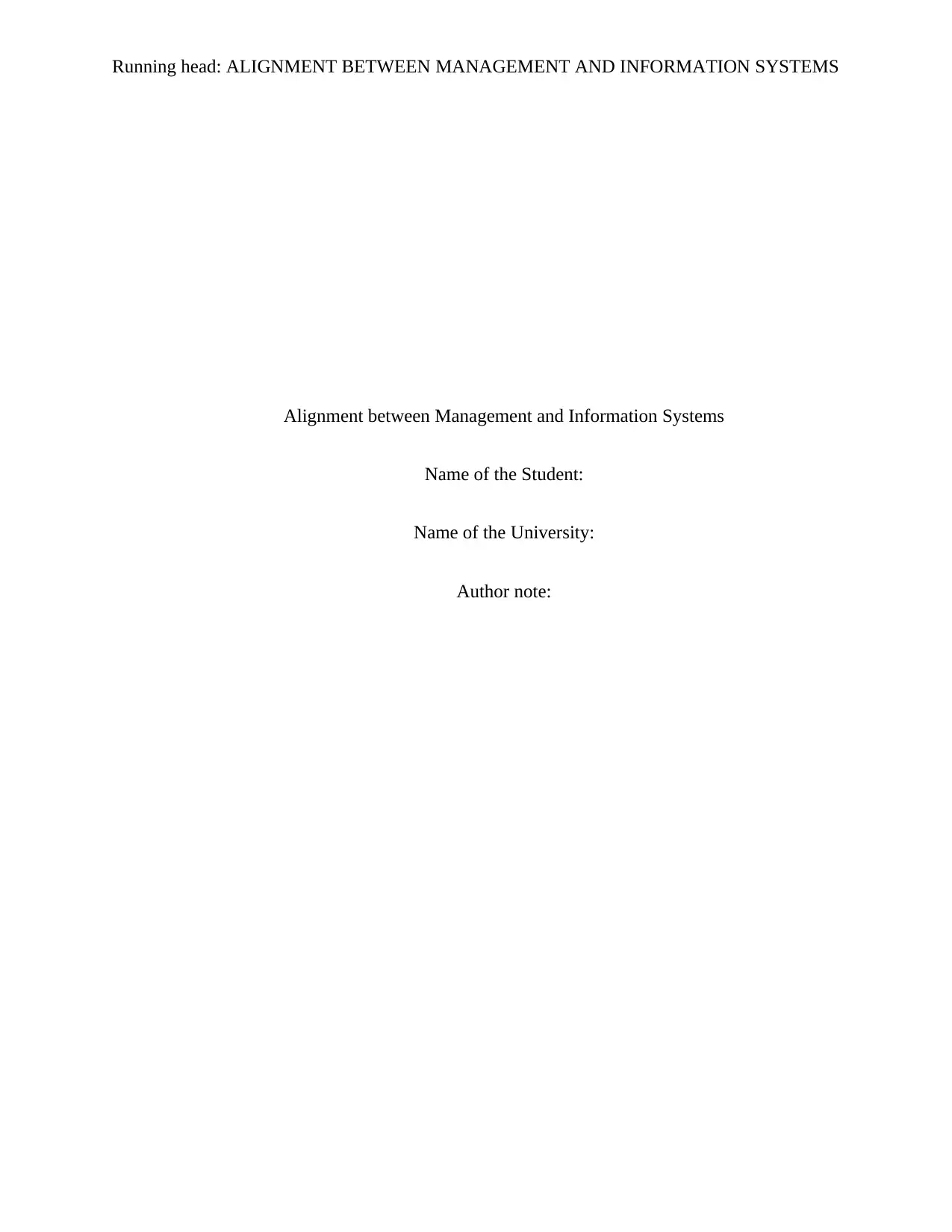
Running head: ALIGNMENT BETWEEN MANAGEMENT AND INFORMATION SYSTEMS
Alignment between Management and Information Systems
Name of the Student:
Name of the University:
Author note:
Alignment between Management and Information Systems
Name of the Student:
Name of the University:
Author note:
Secure Best Marks with AI Grader
Need help grading? Try our AI Grader for instant feedback on your assignments.
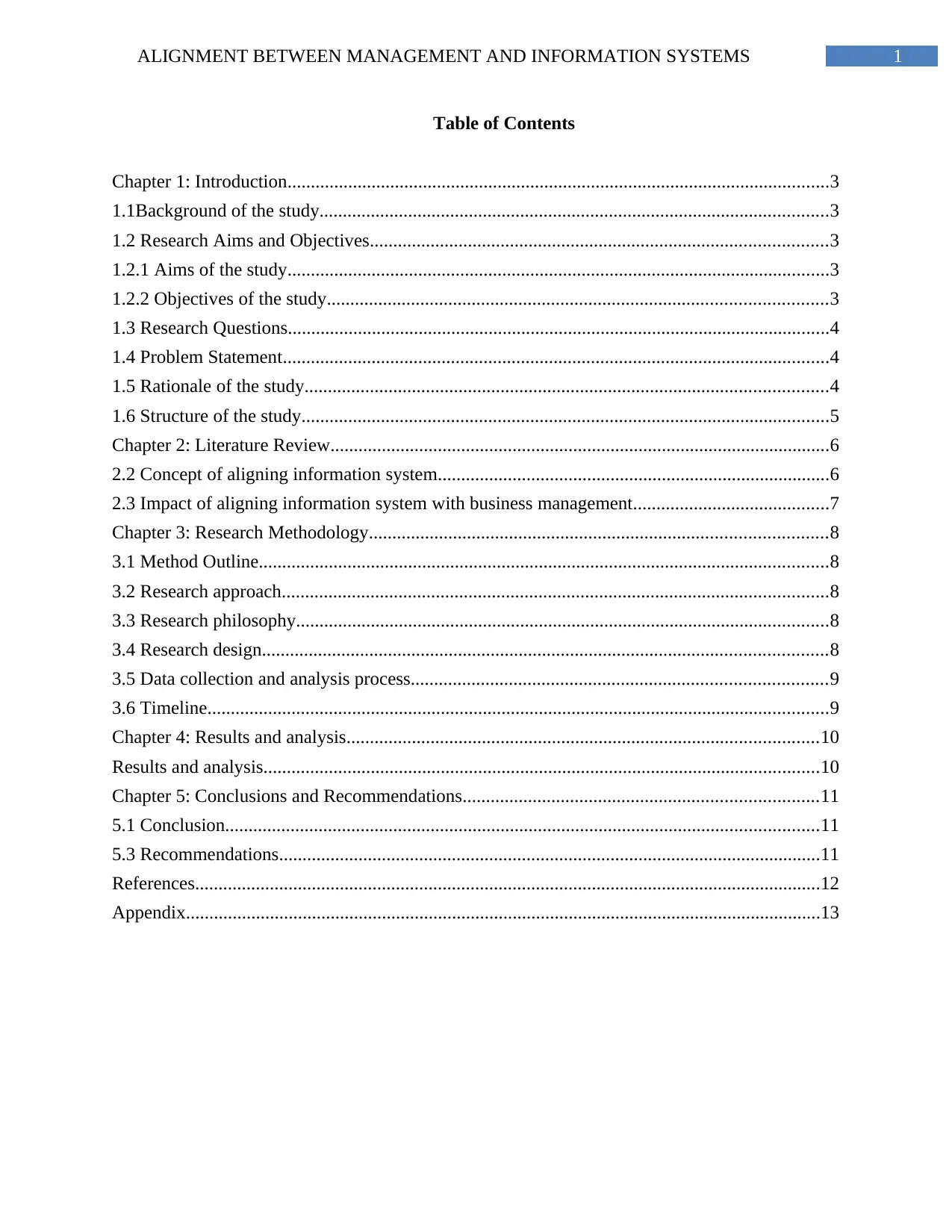
1ALIGNMENT BETWEEN MANAGEMENT AND INFORMATION SYSTEMS
Table of Contents
Chapter 1: Introduction....................................................................................................................3
1.1Background of the study.............................................................................................................3
1.2 Research Aims and Objectives..................................................................................................3
1.2.1 Aims of the study....................................................................................................................3
1.2.2 Objectives of the study...........................................................................................................3
1.3 Research Questions....................................................................................................................4
1.4 Problem Statement.....................................................................................................................4
1.5 Rationale of the study................................................................................................................4
1.6 Structure of the study.................................................................................................................5
Chapter 2: Literature Review...........................................................................................................6
2.2 Concept of aligning information system....................................................................................6
2.3 Impact of aligning information system with business management..........................................7
Chapter 3: Research Methodology..................................................................................................8
3.1 Method Outline..........................................................................................................................8
3.2 Research approach.....................................................................................................................8
3.3 Research philosophy..................................................................................................................8
3.4 Research design.........................................................................................................................8
3.5 Data collection and analysis process.........................................................................................9
3.6 Timeline.....................................................................................................................................9
Chapter 4: Results and analysis.....................................................................................................10
Results and analysis.......................................................................................................................10
Chapter 5: Conclusions and Recommendations............................................................................11
5.1 Conclusion...............................................................................................................................11
5.3 Recommendations....................................................................................................................11
References......................................................................................................................................12
Appendix........................................................................................................................................13
Table of Contents
Chapter 1: Introduction....................................................................................................................3
1.1Background of the study.............................................................................................................3
1.2 Research Aims and Objectives..................................................................................................3
1.2.1 Aims of the study....................................................................................................................3
1.2.2 Objectives of the study...........................................................................................................3
1.3 Research Questions....................................................................................................................4
1.4 Problem Statement.....................................................................................................................4
1.5 Rationale of the study................................................................................................................4
1.6 Structure of the study.................................................................................................................5
Chapter 2: Literature Review...........................................................................................................6
2.2 Concept of aligning information system....................................................................................6
2.3 Impact of aligning information system with business management..........................................7
Chapter 3: Research Methodology..................................................................................................8
3.1 Method Outline..........................................................................................................................8
3.2 Research approach.....................................................................................................................8
3.3 Research philosophy..................................................................................................................8
3.4 Research design.........................................................................................................................8
3.5 Data collection and analysis process.........................................................................................9
3.6 Timeline.....................................................................................................................................9
Chapter 4: Results and analysis.....................................................................................................10
Results and analysis.......................................................................................................................10
Chapter 5: Conclusions and Recommendations............................................................................11
5.1 Conclusion...............................................................................................................................11
5.3 Recommendations....................................................................................................................11
References......................................................................................................................................12
Appendix........................................................................................................................................13
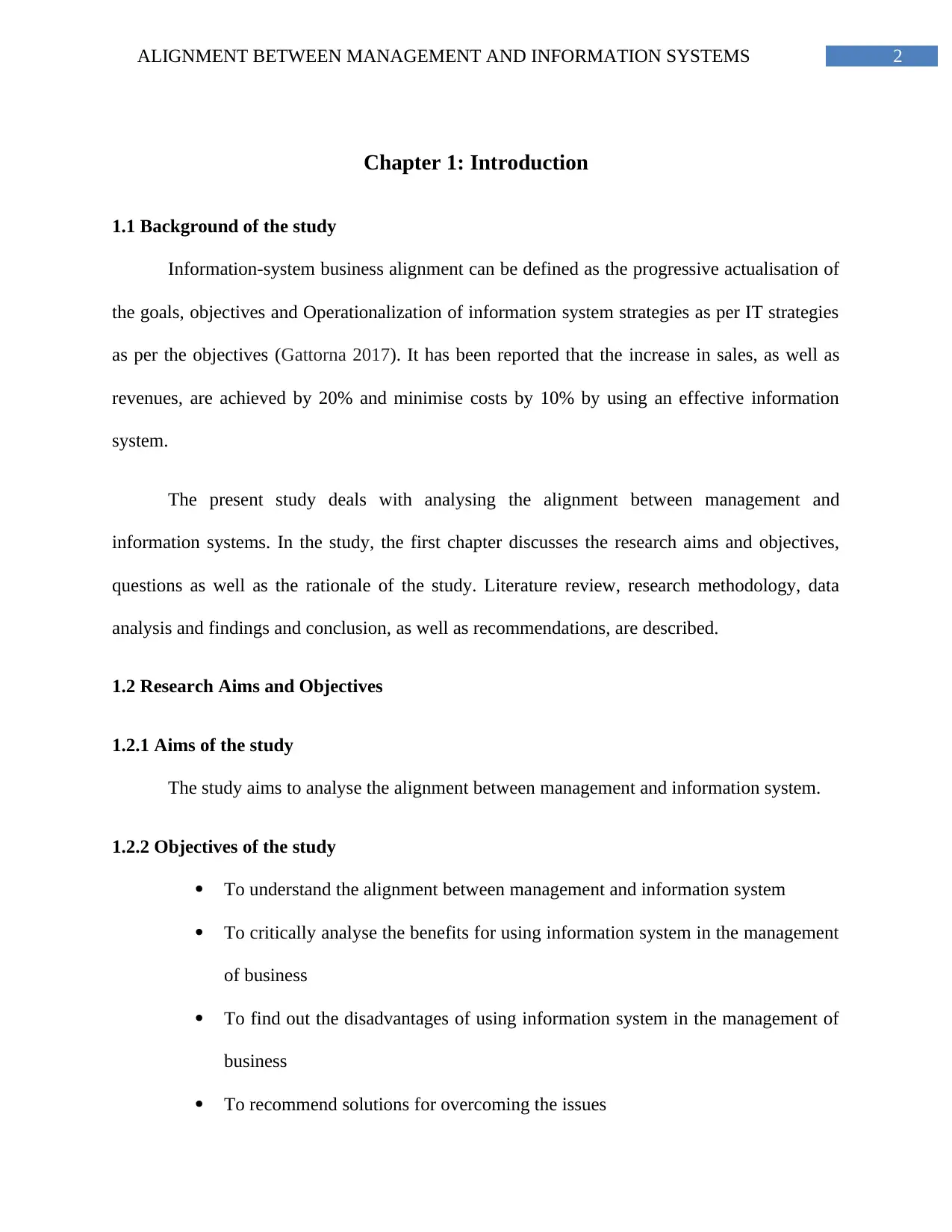
2ALIGNMENT BETWEEN MANAGEMENT AND INFORMATION SYSTEMS
Chapter 1: Introduction
1.1 Background of the study
Information-system business alignment can be defined as the progressive actualisation of
the goals, objectives and Operationalization of information system strategies as per IT strategies
as per the objectives (Gattorna 2017). It has been reported that the increase in sales, as well as
revenues, are achieved by 20% and minimise costs by 10% by using an effective information
system.
The present study deals with analysing the alignment between management and
information systems. In the study, the first chapter discusses the research aims and objectives,
questions as well as the rationale of the study. Literature review, research methodology, data
analysis and findings and conclusion, as well as recommendations, are described.
1.2 Research Aims and Objectives
1.2.1 Aims of the study
The study aims to analyse the alignment between management and information system.
1.2.2 Objectives of the study
To understand the alignment between management and information system
To critically analyse the benefits for using information system in the management
of business
To find out the disadvantages of using information system in the management of
business
To recommend solutions for overcoming the issues
Chapter 1: Introduction
1.1 Background of the study
Information-system business alignment can be defined as the progressive actualisation of
the goals, objectives and Operationalization of information system strategies as per IT strategies
as per the objectives (Gattorna 2017). It has been reported that the increase in sales, as well as
revenues, are achieved by 20% and minimise costs by 10% by using an effective information
system.
The present study deals with analysing the alignment between management and
information systems. In the study, the first chapter discusses the research aims and objectives,
questions as well as the rationale of the study. Literature review, research methodology, data
analysis and findings and conclusion, as well as recommendations, are described.
1.2 Research Aims and Objectives
1.2.1 Aims of the study
The study aims to analyse the alignment between management and information system.
1.2.2 Objectives of the study
To understand the alignment between management and information system
To critically analyse the benefits for using information system in the management
of business
To find out the disadvantages of using information system in the management of
business
To recommend solutions for overcoming the issues
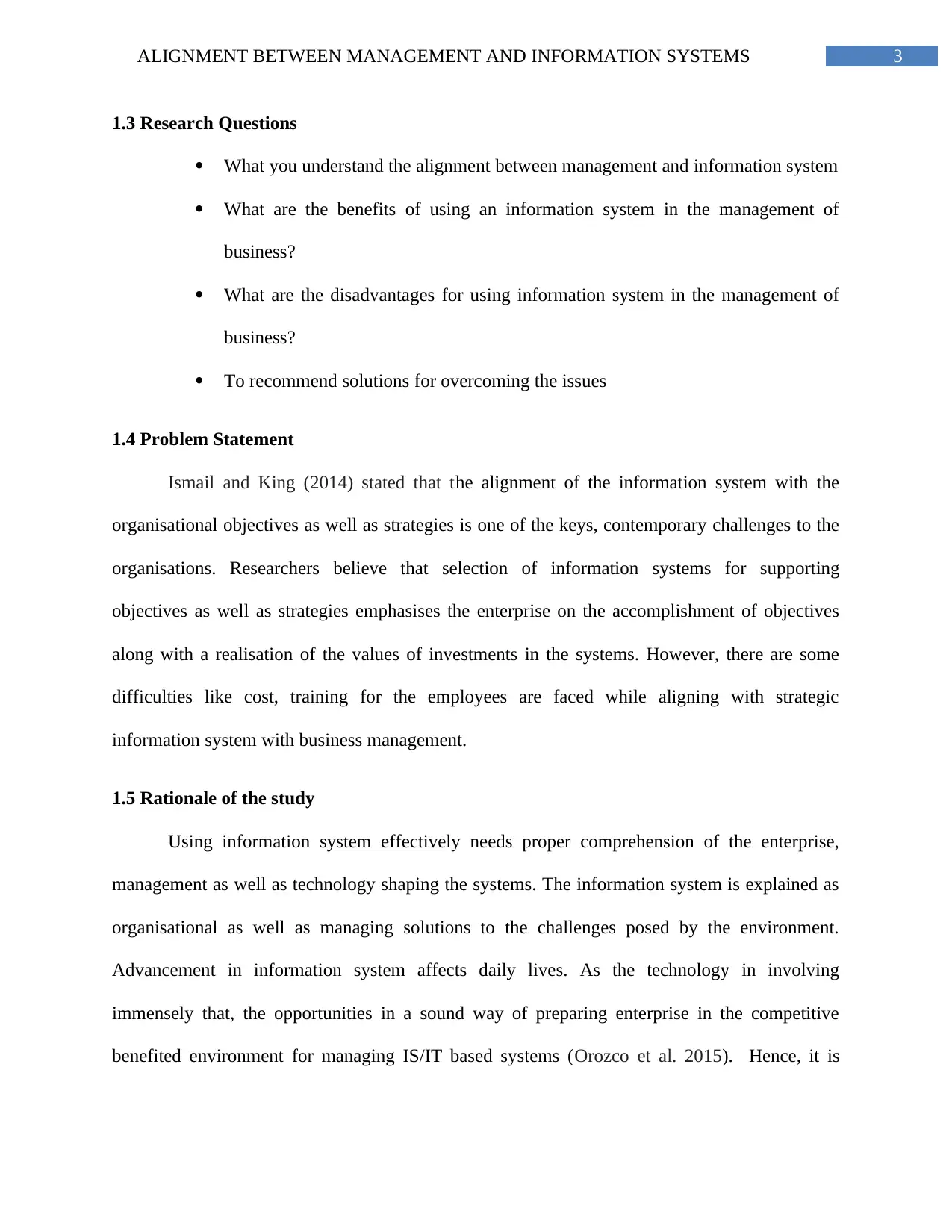
3ALIGNMENT BETWEEN MANAGEMENT AND INFORMATION SYSTEMS
1.3 Research Questions
What you understand the alignment between management and information system
What are the benefits of using an information system in the management of
business?
What are the disadvantages for using information system in the management of
business?
To recommend solutions for overcoming the issues
1.4 Problem Statement
Ismail and King (2014) stated that the alignment of the information system with the
organisational objectives as well as strategies is one of the keys, contemporary challenges to the
organisations. Researchers believe that selection of information systems for supporting
objectives as well as strategies emphasises the enterprise on the accomplishment of objectives
along with a realisation of the values of investments in the systems. However, there are some
difficulties like cost, training for the employees are faced while aligning with strategic
information system with business management.
1.5 Rationale of the study
Using information system effectively needs proper comprehension of the enterprise,
management as well as technology shaping the systems. The information system is explained as
organisational as well as managing solutions to the challenges posed by the environment.
Advancement in information system affects daily lives. As the technology in involving
immensely that, the opportunities in a sound way of preparing enterprise in the competitive
benefited environment for managing IS/IT based systems (Orozco et al. 2015). Hence, it is
1.3 Research Questions
What you understand the alignment between management and information system
What are the benefits of using an information system in the management of
business?
What are the disadvantages for using information system in the management of
business?
To recommend solutions for overcoming the issues
1.4 Problem Statement
Ismail and King (2014) stated that the alignment of the information system with the
organisational objectives as well as strategies is one of the keys, contemporary challenges to the
organisations. Researchers believe that selection of information systems for supporting
objectives as well as strategies emphasises the enterprise on the accomplishment of objectives
along with a realisation of the values of investments in the systems. However, there are some
difficulties like cost, training for the employees are faced while aligning with strategic
information system with business management.
1.5 Rationale of the study
Using information system effectively needs proper comprehension of the enterprise,
management as well as technology shaping the systems. The information system is explained as
organisational as well as managing solutions to the challenges posed by the environment.
Advancement in information system affects daily lives. As the technology in involving
immensely that, the opportunities in a sound way of preparing enterprise in the competitive
benefited environment for managing IS/IT based systems (Orozco et al. 2015). Hence, it is
Secure Best Marks with AI Grader
Need help grading? Try our AI Grader for instant feedback on your assignments.
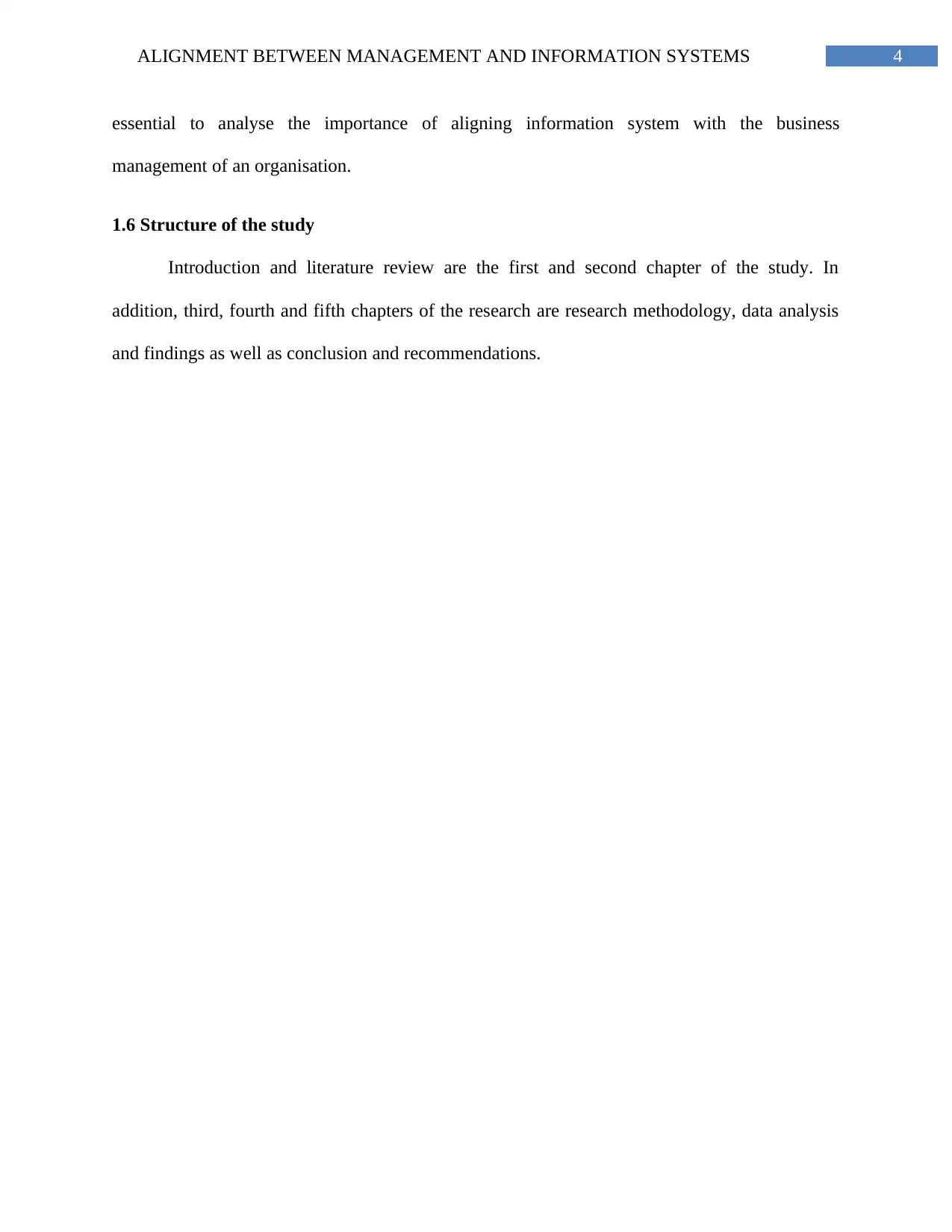
4ALIGNMENT BETWEEN MANAGEMENT AND INFORMATION SYSTEMS
essential to analyse the importance of aligning information system with the business
management of an organisation.
1.6 Structure of the study
Introduction and literature review are the first and second chapter of the study. In
addition, third, fourth and fifth chapters of the research are research methodology, data analysis
and findings as well as conclusion and recommendations.
essential to analyse the importance of aligning information system with the business
management of an organisation.
1.6 Structure of the study
Introduction and literature review are the first and second chapter of the study. In
addition, third, fourth and fifth chapters of the research are research methodology, data analysis
and findings as well as conclusion and recommendations.
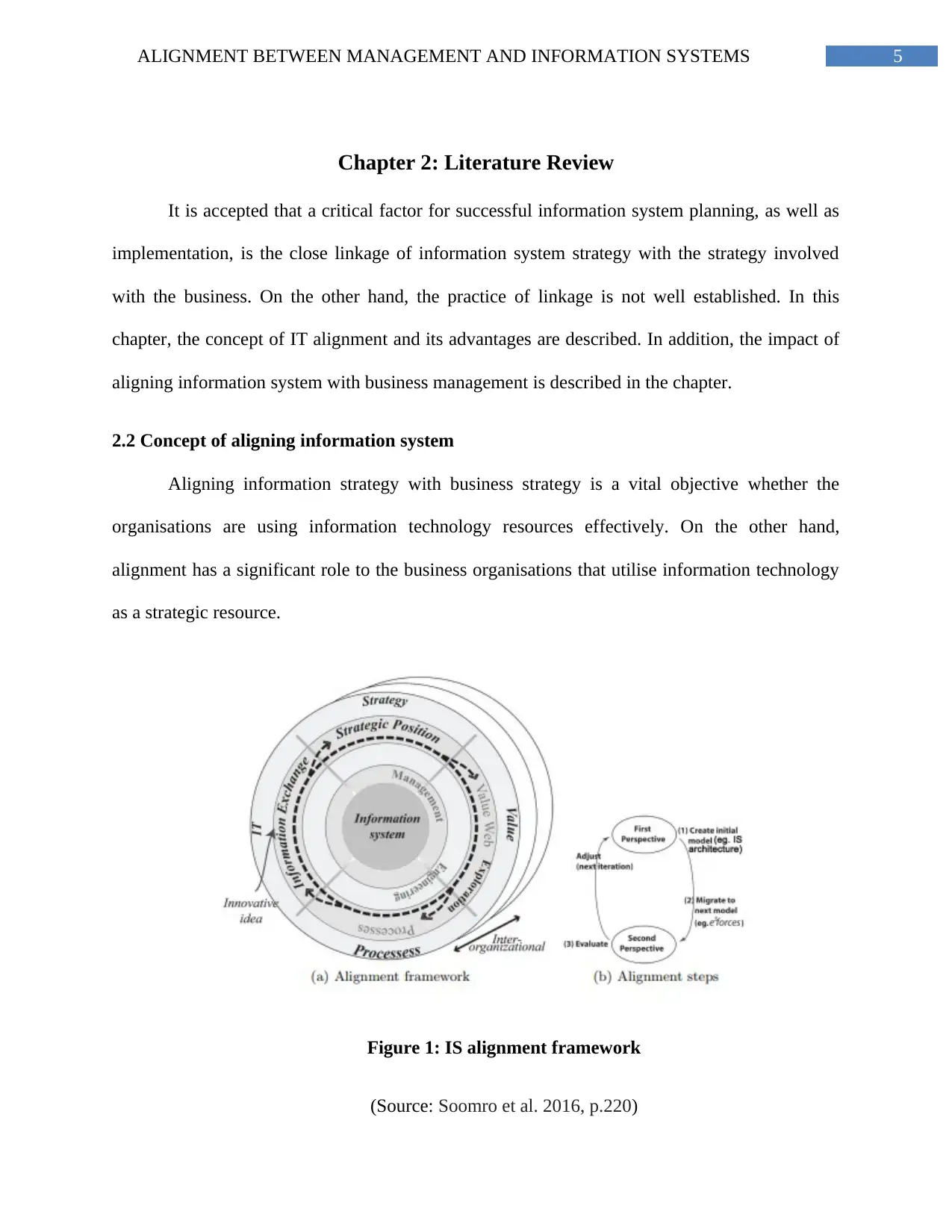
5ALIGNMENT BETWEEN MANAGEMENT AND INFORMATION SYSTEMS
Chapter 2: Literature Review
It is accepted that a critical factor for successful information system planning, as well as
implementation, is the close linkage of information system strategy with the strategy involved
with the business. On the other hand, the practice of linkage is not well established. In this
chapter, the concept of IT alignment and its advantages are described. In addition, the impact of
aligning information system with business management is described in the chapter.
2.2 Concept of aligning information system
Aligning information strategy with business strategy is a vital objective whether the
organisations are using information technology resources effectively. On the other hand,
alignment has a significant role to the business organisations that utilise information technology
as a strategic resource.
Figure 1: IS alignment framework
(Source: Soomro et al. 2016, p.220)
Chapter 2: Literature Review
It is accepted that a critical factor for successful information system planning, as well as
implementation, is the close linkage of information system strategy with the strategy involved
with the business. On the other hand, the practice of linkage is not well established. In this
chapter, the concept of IT alignment and its advantages are described. In addition, the impact of
aligning information system with business management is described in the chapter.
2.2 Concept of aligning information system
Aligning information strategy with business strategy is a vital objective whether the
organisations are using information technology resources effectively. On the other hand,
alignment has a significant role to the business organisations that utilise information technology
as a strategic resource.
Figure 1: IS alignment framework
(Source: Soomro et al. 2016, p.220)
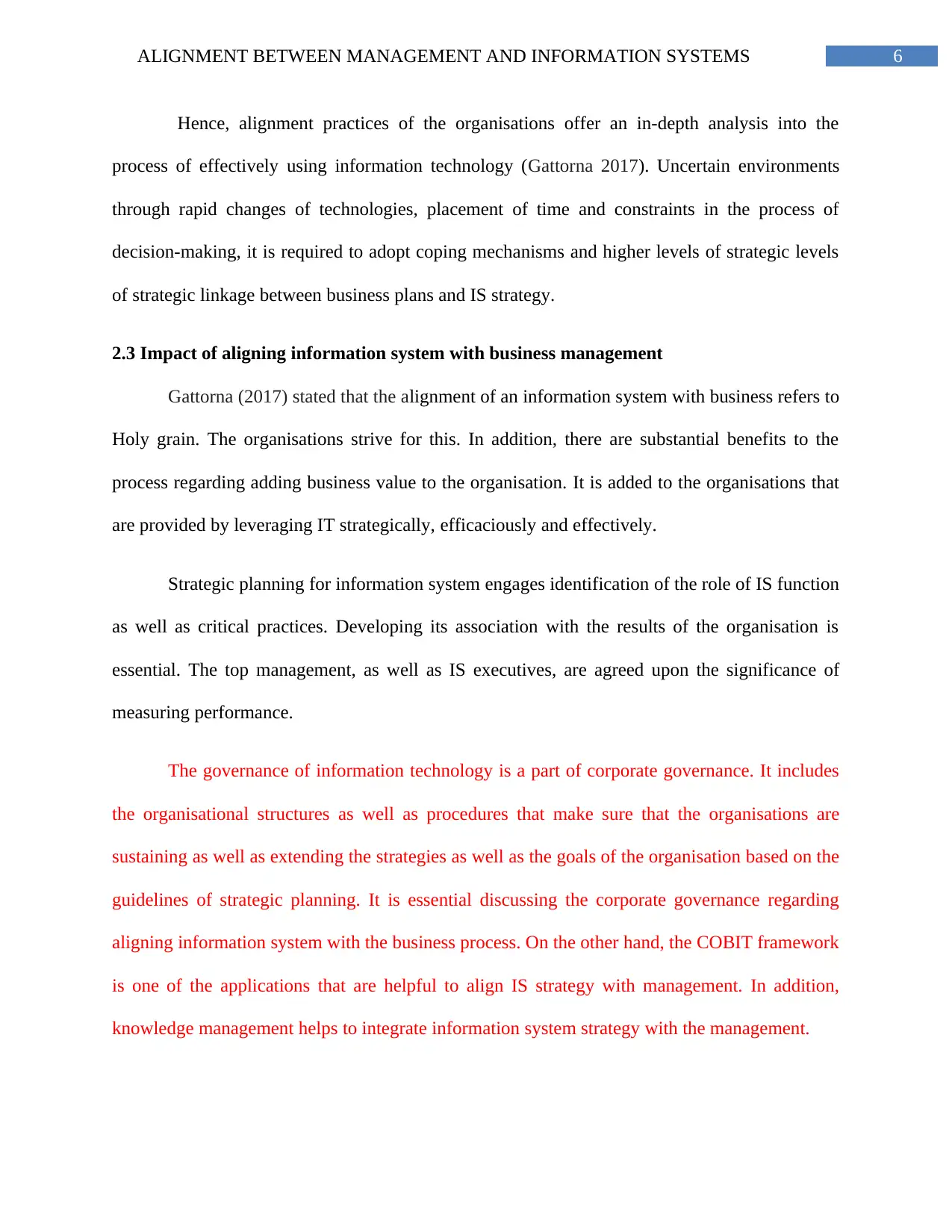
6ALIGNMENT BETWEEN MANAGEMENT AND INFORMATION SYSTEMS
Hence, alignment practices of the organisations offer an in-depth analysis into the
process of effectively using information technology (Gattorna 2017). Uncertain environments
through rapid changes of technologies, placement of time and constraints in the process of
decision-making, it is required to adopt coping mechanisms and higher levels of strategic levels
of strategic linkage between business plans and IS strategy.
2.3 Impact of aligning information system with business management
Gattorna (2017) stated that the alignment of an information system with business refers to
Holy grain. The organisations strive for this. In addition, there are substantial benefits to the
process regarding adding business value to the organisation. It is added to the organisations that
are provided by leveraging IT strategically, efficaciously and effectively.
Strategic planning for information system engages identification of the role of IS function
as well as critical practices. Developing its association with the results of the organisation is
essential. The top management, as well as IS executives, are agreed upon the significance of
measuring performance.
The governance of information technology is a part of corporate governance. It includes
the organisational structures as well as procedures that make sure that the organisations are
sustaining as well as extending the strategies as well as the goals of the organisation based on the
guidelines of strategic planning. It is essential discussing the corporate governance regarding
aligning information system with the business process. On the other hand, the COBIT framework
is one of the applications that are helpful to align IS strategy with management. In addition,
knowledge management helps to integrate information system strategy with the management.
Hence, alignment practices of the organisations offer an in-depth analysis into the
process of effectively using information technology (Gattorna 2017). Uncertain environments
through rapid changes of technologies, placement of time and constraints in the process of
decision-making, it is required to adopt coping mechanisms and higher levels of strategic levels
of strategic linkage between business plans and IS strategy.
2.3 Impact of aligning information system with business management
Gattorna (2017) stated that the alignment of an information system with business refers to
Holy grain. The organisations strive for this. In addition, there are substantial benefits to the
process regarding adding business value to the organisation. It is added to the organisations that
are provided by leveraging IT strategically, efficaciously and effectively.
Strategic planning for information system engages identification of the role of IS function
as well as critical practices. Developing its association with the results of the organisation is
essential. The top management, as well as IS executives, are agreed upon the significance of
measuring performance.
The governance of information technology is a part of corporate governance. It includes
the organisational structures as well as procedures that make sure that the organisations are
sustaining as well as extending the strategies as well as the goals of the organisation based on the
guidelines of strategic planning. It is essential discussing the corporate governance regarding
aligning information system with the business process. On the other hand, the COBIT framework
is one of the applications that are helpful to align IS strategy with management. In addition,
knowledge management helps to integrate information system strategy with the management.
Paraphrase This Document
Need a fresh take? Get an instant paraphrase of this document with our AI Paraphraser
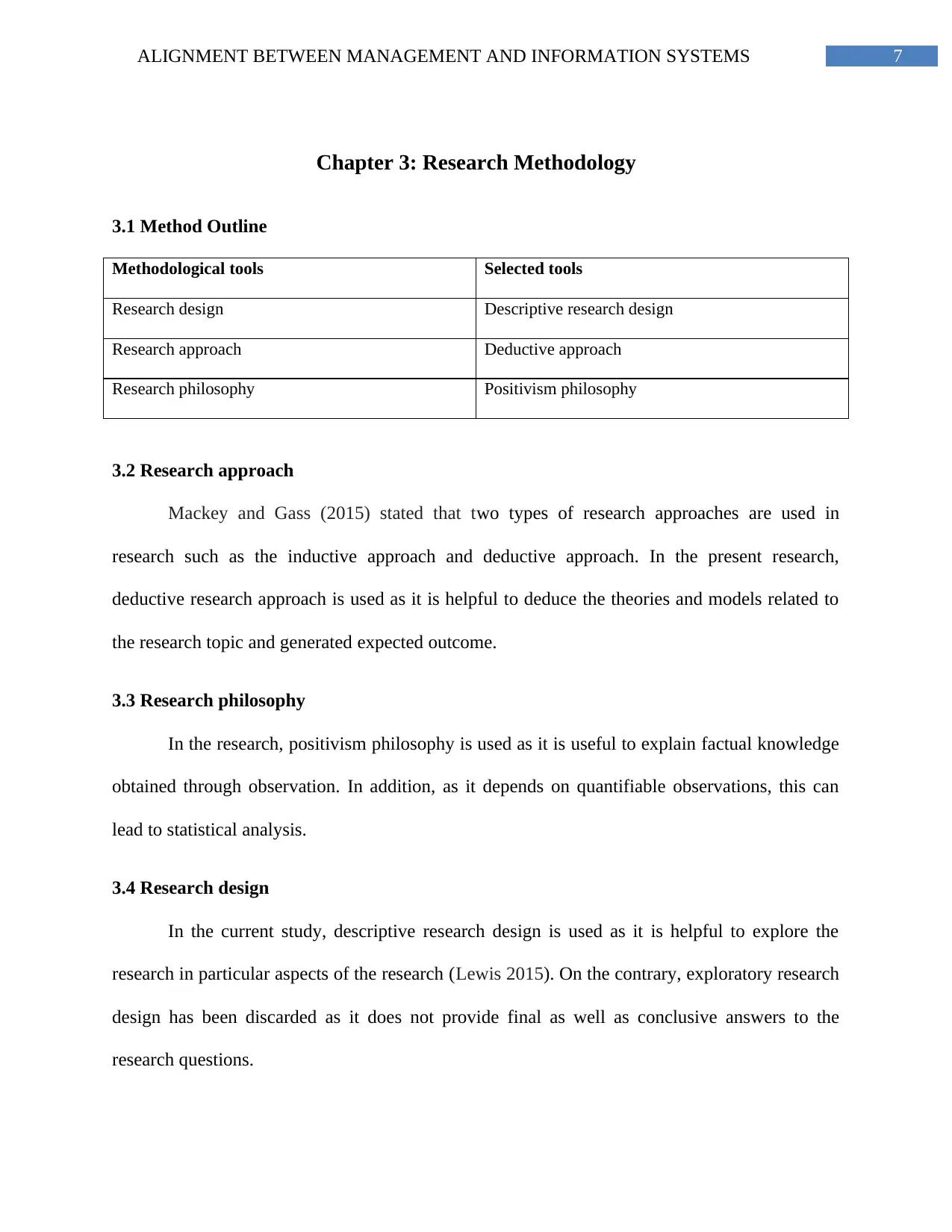
7ALIGNMENT BETWEEN MANAGEMENT AND INFORMATION SYSTEMS
Chapter 3: Research Methodology
3.1 Method Outline
Methodological tools Selected tools
Research design Descriptive research design
Research approach Deductive approach
Research philosophy Positivism philosophy
3.2 Research approach
Mackey and Gass (2015) stated that two types of research approaches are used in
research such as the inductive approach and deductive approach. In the present research,
deductive research approach is used as it is helpful to deduce the theories and models related to
the research topic and generated expected outcome.
3.3 Research philosophy
In the research, positivism philosophy is used as it is useful to explain factual knowledge
obtained through observation. In addition, as it depends on quantifiable observations, this can
lead to statistical analysis.
3.4 Research design
In the current study, descriptive research design is used as it is helpful to explore the
research in particular aspects of the research (Lewis 2015). On the contrary, exploratory research
design has been discarded as it does not provide final as well as conclusive answers to the
research questions.
Chapter 3: Research Methodology
3.1 Method Outline
Methodological tools Selected tools
Research design Descriptive research design
Research approach Deductive approach
Research philosophy Positivism philosophy
3.2 Research approach
Mackey and Gass (2015) stated that two types of research approaches are used in
research such as the inductive approach and deductive approach. In the present research,
deductive research approach is used as it is helpful to deduce the theories and models related to
the research topic and generated expected outcome.
3.3 Research philosophy
In the research, positivism philosophy is used as it is useful to explain factual knowledge
obtained through observation. In addition, as it depends on quantifiable observations, this can
lead to statistical analysis.
3.4 Research design
In the current study, descriptive research design is used as it is helpful to explore the
research in particular aspects of the research (Lewis 2015). On the contrary, exploratory research
design has been discarded as it does not provide final as well as conclusive answers to the
research questions.
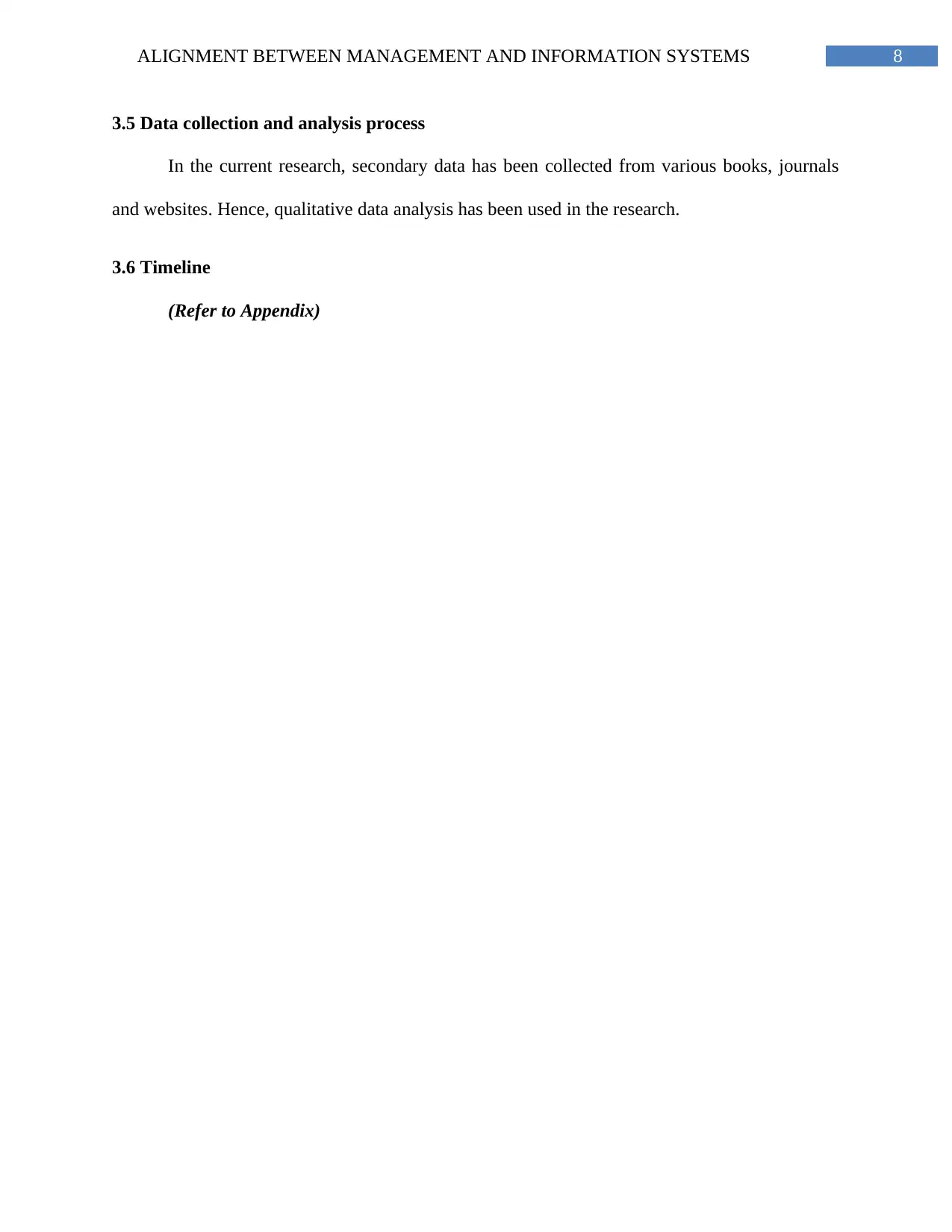
8ALIGNMENT BETWEEN MANAGEMENT AND INFORMATION SYSTEMS
3.5 Data collection and analysis process
In the current research, secondary data has been collected from various books, journals
and websites. Hence, qualitative data analysis has been used in the research.
3.6 Timeline
(Refer to Appendix)
3.5 Data collection and analysis process
In the current research, secondary data has been collected from various books, journals
and websites. Hence, qualitative data analysis has been used in the research.
3.6 Timeline
(Refer to Appendix)
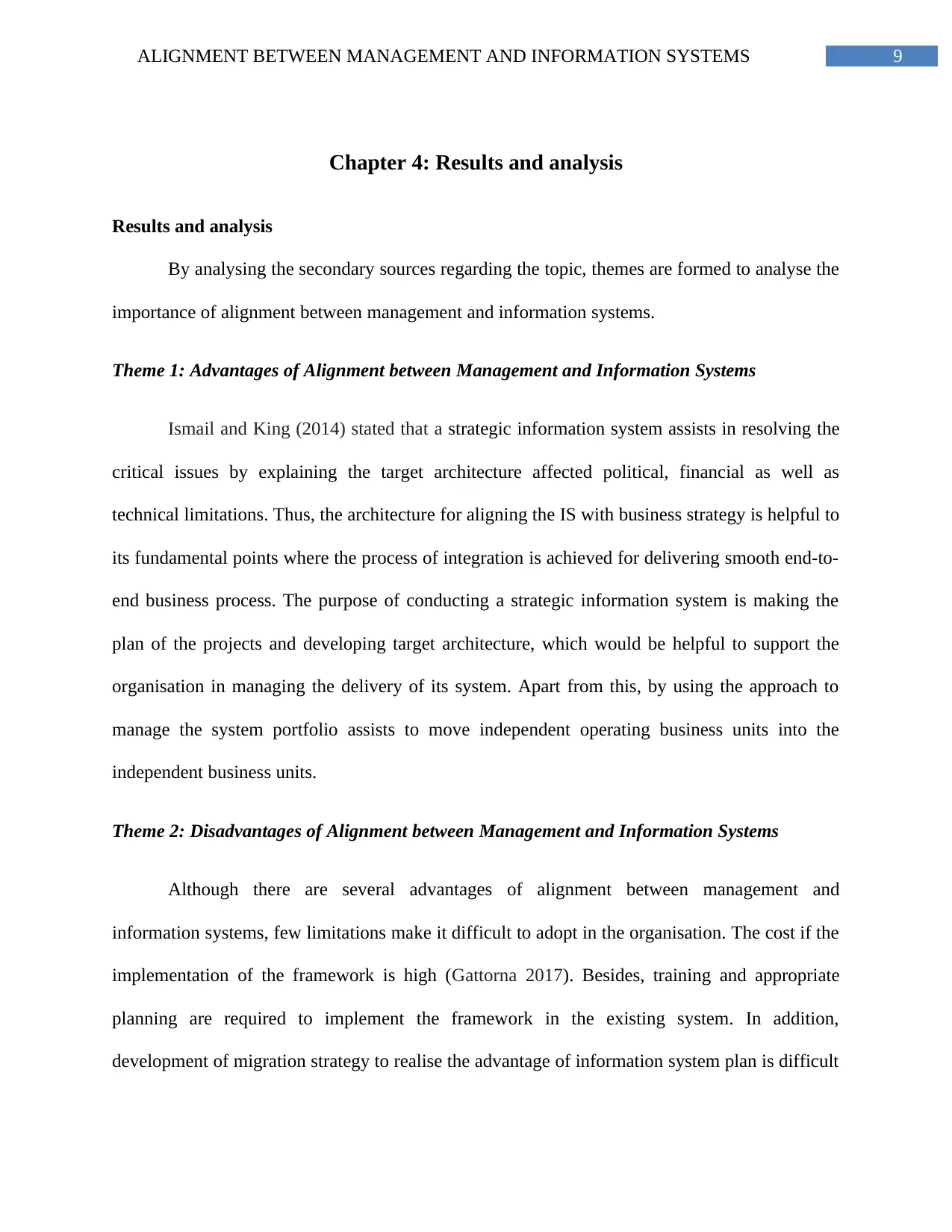
9ALIGNMENT BETWEEN MANAGEMENT AND INFORMATION SYSTEMS
Chapter 4: Results and analysis
Results and analysis
By analysing the secondary sources regarding the topic, themes are formed to analyse the
importance of alignment between management and information systems.
Theme 1: Advantages of Alignment between Management and Information Systems
Ismail and King (2014) stated that a strategic information system assists in resolving the
critical issues by explaining the target architecture affected political, financial as well as
technical limitations. Thus, the architecture for aligning the IS with business strategy is helpful to
its fundamental points where the process of integration is achieved for delivering smooth end-to-
end business process. The purpose of conducting a strategic information system is making the
plan of the projects and developing target architecture, which would be helpful to support the
organisation in managing the delivery of its system. Apart from this, by using the approach to
manage the system portfolio assists to move independent operating business units into the
independent business units.
Theme 2: Disadvantages of Alignment between Management and Information Systems
Although there are several advantages of alignment between management and
information systems, few limitations make it difficult to adopt in the organisation. The cost if the
implementation of the framework is high (Gattorna 2017). Besides, training and appropriate
planning are required to implement the framework in the existing system. In addition,
development of migration strategy to realise the advantage of information system plan is difficult
Chapter 4: Results and analysis
Results and analysis
By analysing the secondary sources regarding the topic, themes are formed to analyse the
importance of alignment between management and information systems.
Theme 1: Advantages of Alignment between Management and Information Systems
Ismail and King (2014) stated that a strategic information system assists in resolving the
critical issues by explaining the target architecture affected political, financial as well as
technical limitations. Thus, the architecture for aligning the IS with business strategy is helpful to
its fundamental points where the process of integration is achieved for delivering smooth end-to-
end business process. The purpose of conducting a strategic information system is making the
plan of the projects and developing target architecture, which would be helpful to support the
organisation in managing the delivery of its system. Apart from this, by using the approach to
manage the system portfolio assists to move independent operating business units into the
independent business units.
Theme 2: Disadvantages of Alignment between Management and Information Systems
Although there are several advantages of alignment between management and
information systems, few limitations make it difficult to adopt in the organisation. The cost if the
implementation of the framework is high (Gattorna 2017). Besides, training and appropriate
planning are required to implement the framework in the existing system. In addition,
development of migration strategy to realise the advantage of information system plan is difficult
Secure Best Marks with AI Grader
Need help grading? Try our AI Grader for instant feedback on your assignments.
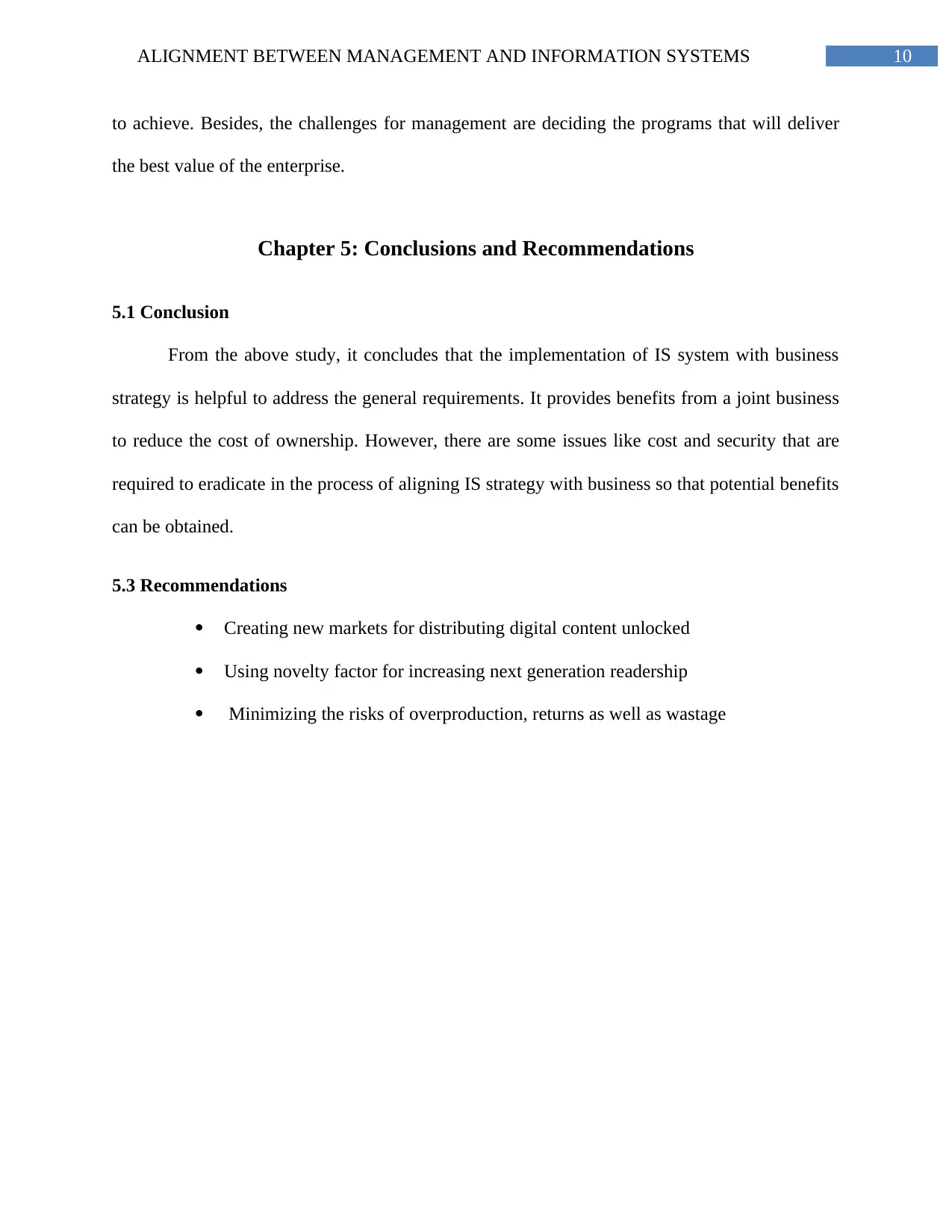
10ALIGNMENT BETWEEN MANAGEMENT AND INFORMATION SYSTEMS
to achieve. Besides, the challenges for management are deciding the programs that will deliver
the best value of the enterprise.
Chapter 5: Conclusions and Recommendations
5.1 Conclusion
From the above study, it concludes that the implementation of IS system with business
strategy is helpful to address the general requirements. It provides benefits from a joint business
to reduce the cost of ownership. However, there are some issues like cost and security that are
required to eradicate in the process of aligning IS strategy with business so that potential benefits
can be obtained.
5.3 Recommendations
Creating new markets for distributing digital content unlocked
Using novelty factor for increasing next generation readership
Minimizing the risks of overproduction, returns as well as wastage
to achieve. Besides, the challenges for management are deciding the programs that will deliver
the best value of the enterprise.
Chapter 5: Conclusions and Recommendations
5.1 Conclusion
From the above study, it concludes that the implementation of IS system with business
strategy is helpful to address the general requirements. It provides benefits from a joint business
to reduce the cost of ownership. However, there are some issues like cost and security that are
required to eradicate in the process of aligning IS strategy with business so that potential benefits
can be obtained.
5.3 Recommendations
Creating new markets for distributing digital content unlocked
Using novelty factor for increasing next generation readership
Minimizing the risks of overproduction, returns as well as wastage
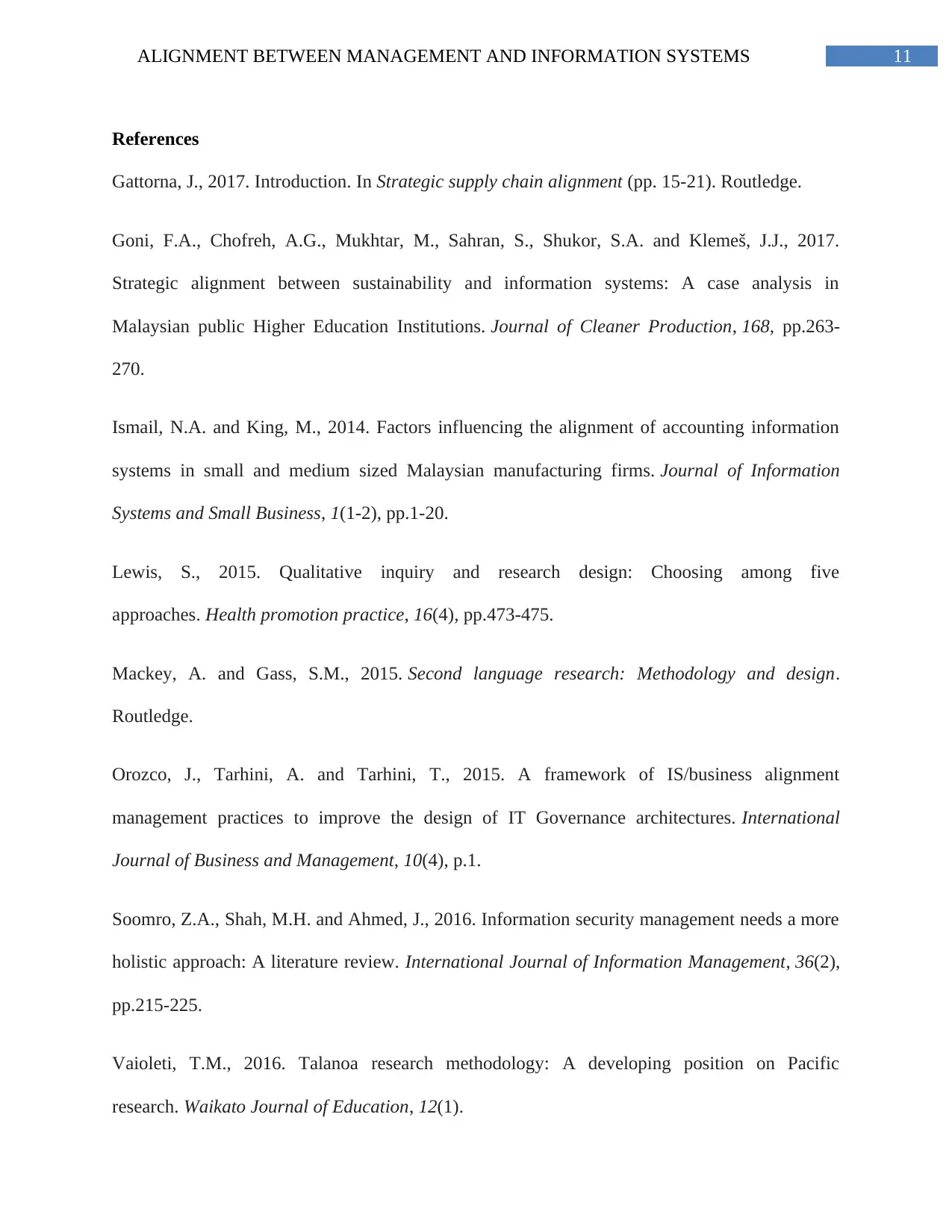
11ALIGNMENT BETWEEN MANAGEMENT AND INFORMATION SYSTEMS
References
Gattorna, J., 2017. Introduction. In Strategic supply chain alignment (pp. 15-21). Routledge.
Goni, F.A., Chofreh, A.G., Mukhtar, M., Sahran, S., Shukor, S.A. and Klemeš, J.J., 2017.
Strategic alignment between sustainability and information systems: A case analysis in
Malaysian public Higher Education Institutions. Journal of Cleaner Production, 168, pp.263-
270.
Ismail, N.A. and King, M., 2014. Factors influencing the alignment of accounting information
systems in small and medium sized Malaysian manufacturing firms. Journal of Information
Systems and Small Business, 1(1-2), pp.1-20.
Lewis, S., 2015. Qualitative inquiry and research design: Choosing among five
approaches. Health promotion practice, 16(4), pp.473-475.
Mackey, A. and Gass, S.M., 2015. Second language research: Methodology and design.
Routledge.
Orozco, J., Tarhini, A. and Tarhini, T., 2015. A framework of IS/business alignment
management practices to improve the design of IT Governance architectures. International
Journal of Business and Management, 10(4), p.1.
Soomro, Z.A., Shah, M.H. and Ahmed, J., 2016. Information security management needs a more
holistic approach: A literature review. International Journal of Information Management, 36(2),
pp.215-225.
Vaioleti, T.M., 2016. Talanoa research methodology: A developing position on Pacific
research. Waikato Journal of Education, 12(1).
References
Gattorna, J., 2017. Introduction. In Strategic supply chain alignment (pp. 15-21). Routledge.
Goni, F.A., Chofreh, A.G., Mukhtar, M., Sahran, S., Shukor, S.A. and Klemeš, J.J., 2017.
Strategic alignment between sustainability and information systems: A case analysis in
Malaysian public Higher Education Institutions. Journal of Cleaner Production, 168, pp.263-
270.
Ismail, N.A. and King, M., 2014. Factors influencing the alignment of accounting information
systems in small and medium sized Malaysian manufacturing firms. Journal of Information
Systems and Small Business, 1(1-2), pp.1-20.
Lewis, S., 2015. Qualitative inquiry and research design: Choosing among five
approaches. Health promotion practice, 16(4), pp.473-475.
Mackey, A. and Gass, S.M., 2015. Second language research: Methodology and design.
Routledge.
Orozco, J., Tarhini, A. and Tarhini, T., 2015. A framework of IS/business alignment
management practices to improve the design of IT Governance architectures. International
Journal of Business and Management, 10(4), p.1.
Soomro, Z.A., Shah, M.H. and Ahmed, J., 2016. Information security management needs a more
holistic approach: A literature review. International Journal of Information Management, 36(2),
pp.215-225.
Vaioleti, T.M., 2016. Talanoa research methodology: A developing position on Pacific
research. Waikato Journal of Education, 12(1).
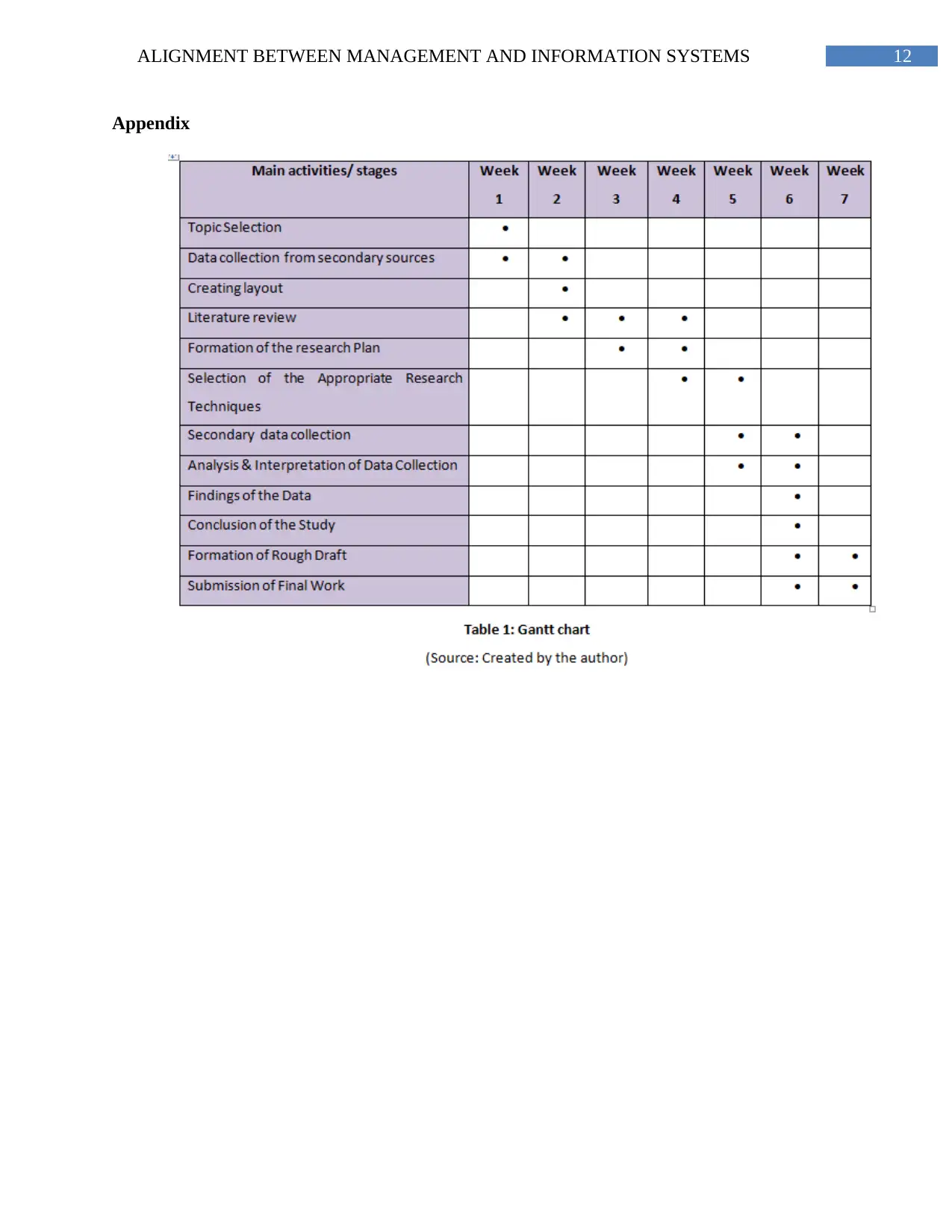
12ALIGNMENT BETWEEN MANAGEMENT AND INFORMATION SYSTEMS
Appendix
Appendix
1 out of 13
Related Documents
Your All-in-One AI-Powered Toolkit for Academic Success.
+13062052269
info@desklib.com
Available 24*7 on WhatsApp / Email
![[object Object]](/_next/static/media/star-bottom.7253800d.svg)
Unlock your academic potential
© 2024 | Zucol Services PVT LTD | All rights reserved.




